Plankton
Plankton are the diverse collection of
Marine plankton include
Although plankton are usually thought of as inhabiting water, there are also airborne versions that live part of their lives drifting in the atmosphere. These .
Though many planktonic species are microscopic in size, plankton includes organisms over a wide range of sizes, including large organisms such as jellyfish.[5] This is because plankton are defined by their ecological niche and level of motility rather than by any phylogenetic or taxonomic classification. The "plankton" category differentiates these organisms from those that float on the water's surface, called neuston, those that can swim against a current, called nekton, and those that live on the deep sea floor, called benthos.
Terminology
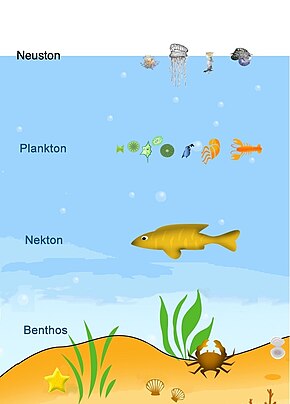
The name plankton was coined by German marine biologist Victor Hensen in 1887 from shortening the word halyplankton from Greek ᾰ̔́λς háls "sea" and πλανάω planáō to "drift" or "wander".[6]: 1 While some forms are capable of independent movement and can swim hundreds of meters vertically in a single day (a behavior called diel vertical migration), their horizontal position is primarily determined by the surrounding water movement, and plankton typically flow with ocean currents. This is in contrast to nekton organisms, such as fish, squid and marine mammals, which can swim against the ambient flow and control their position in the environment.
Within the plankton, holoplankton spend their entire life cycle as plankton (e.g. most algae, copepods, salps, and some jellyfish). By contrast, meroplankton are only planktic for part of their lives (usually the larval stage), and then graduate to either a nektic (swimming) or benthic (sea floor) existence. Examples of meroplankton include the larvae of sea urchins, starfish, crustaceans, marine worms, and most fish.[7]
The amount and distribution of plankton depends on available nutrients, the state of water and a large amount of other plankton.[8]
The study of plankton is termed planktology and a planktonic individual is referred to as a plankter.[9] The adjective planktonic is widely used in both the scientific and popular literature, and is a generally accepted term. However, from the standpoint of prescriptive grammar, the less-commonly used planktic is more strictly the correct adjective. When deriving English words from their Greek or Latin roots, the gender-specific ending (in this case, "-on" which indicates the word is neuter) is normally dropped, using only the root of the word in the derivation.[10]
-
Some marine diatoms — a key phytoplankton group
Trophic groups
| Part of a series on |
| Plankton |
|---|
 |
Plankton are primarily divided into broad functional (or trophic level) groups:
- Phytoplankton (from Greek phyton, or plant) are autotrophic prokaryotic or eukaryotic algae that live near the water surface where there is sufficient light to support photosynthesis. Among the more important groups are the diatoms, cyanobacteria, dinoflagellates, and coccolithophores.
- metazoans (e.g. crustaceans and other animals) that feed on other plankton. Some of the eggs and larvae of larger nektonic animals, such as fish, crustaceans, and annelids, are included here.
- nutrient cycling.[11]
- Bacterioplankton include bacteria and archaea, which play an important role in remineralising organic material down the water column (note that prokaryotic phytoplankton are also bacterioplankton).
Mixoplankton
- Mixotrophs. Plankton have traditionally been categorized as producer, consumer, and recycler groups, but some plankton are able to benefit from more than just one trophic level. In this mixed trophic strategy—known as mixotrophy—organisms act as both producers and consumers, either at the same time or switching between modes of nutrition in response to ambient conditions. This makes it possible to use photosynthesis for growth when nutrients and light are abundant, but switching to eat phytoplankton, zooplankton, or each other when growing conditions are poor. Mixotrophs are divided into two groups; constitutive mixotrophs, CMs, which are able to perform photosynthesis on their own, and non-constitutive mixotrophs, NCMs, which use phagocytosis to engulf phototrophic prey that are either kept alive inside the host cell, which benefit from its photosynthesis, or they digest their prey except for the plastids, which continues to perform photosynthesis (kleptoplasty).[14]
Recognition of the importance of mixotrophy as an ecological strategy is increasing,[15] as well as the wider role this may play in marine biogeochemistry.[16] Studies have shown that mixotrophs are much more important for marine ecology than previously assumed and comprise more than half of all microscopic plankton.[17][18] Their presence acts as a buffer that prevents the collapse of ecosystems during times with little to no light.[19]
Size groups
Plankton are also often described in terms of size. Usually the following divisions are used: [21]
Group Size range
(ESD)Examples Megaplankton > 20 cm Cephalopoda; AmphipodaMacroplankton 2→20 cm Mesoplankton 0.2→20 mm TunicataMicroplankton 20→200 µm large nauplii) Nanoplankton 2→20 µm small XanthophytaPicoplankton 0.2→2 µm small bacteria; ChrysophytaFemtoplankton < 0.2 µm marine viruses
However, some of these terms may be used with very different boundaries, especially on the larger end. The existence and importance of nano- and even smaller plankton was only discovered during the 1980s, but they are thought to make up the largest proportion of all plankton in number and diversity.
The microplankton and smaller groups are microorganisms and operate at low Reynolds numbers, where the viscosity of water is more important than its mass or inertia. [22]
-
Plankton sizes by taxonomic groups [23]
Habitat groups
Marine plankton
Marine plankton includes marine bacteria and archaea, algae, protozoa and drifting or floating animals that inhabit the saltwater of oceans and the brackish waters of estuaries.
Freshwater plankton
Freshwater plankton are similar to marine plankton, but are found inland in the freshwaters of lakes and rivers.
Aeroplankton
-
Sea spray containing marine microorganisms can be swept high into the atmosphere and may travel the globe as aeroplankton before falling back to earth.
The
Geoplankton
Many animals live in terrestrial environments by thriving in transient often microscopic bodies of water and moisture, these include rotifers and gastrotrichs which lay resilient eggs capable of surviving years in dry environments, and some of which can go dormant themselves. Nematodes are usually microscopic with this lifestyle. Water bears, despite only having lifespans of a few months, famously can enter suspended animation during dry or hostile conditions and survive for decades. This allows them to be ubiquitous in terrestrial environments despite needing water to grow and reproduce. Many microscopic crustacean groups like copepods and amphipods (of which sandhoppers are members) and seed shrimp are known to go dormant when dry and live in transient bodies of water too[34]
Other groups
Gelatinous zooplankton

Ichthyoplankton
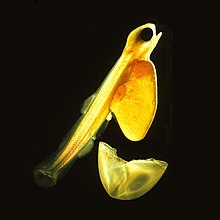
Holoplankton

Meroplankton
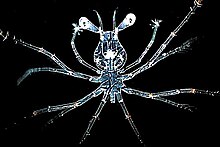
Pseudoplankton
Tychoplankton
Tychoplankton are organisms, such as free-living or attached benthic organisms and other non-planktonic organisms, that are carried into the plankton through a disturbance of their benthic habitat, or by winds and currents.[47] This can occur by direct turbulence or by disruption of the substrate and subsequent entrainment in the water column.[47][48] Tychoplankton are, therefore, a primary subdivision for sorting planktonic organisms by duration of lifecycle spent in the plankton, as neither their entire lives nor particular reproductive portions are confined to planktonic existence.[49] Tychoplankton are sometimes called accidental plankton.
Mineralized plankton
- Some planktons are protected with mineralized shells or tests.
-
The elaboratemarine radiolarians can eventually produce opal.
-
Cliffs of Dover.
-
Planktonicalgae bloom of coccolithophoresoff the southern coast of England
-
Great Pyramids.
Distribution
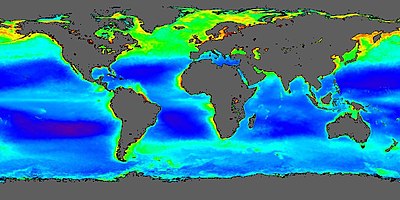
Apart from aeroplankton, plankton inhabits oceans, seas, lakes and ponds. Local abundance varies horizontally, vertically and seasonally. The primary cause of this variability is the availability of light. All plankton ecosystems are driven by the input of solar energy (but see chemosynthesis), confining primary production to surface waters, and to geographical regions and seasons having abundant light.
A secondary variable is nutrient availability. Although large areas of the
Despite significant
While plankton are most abundant in surface waters, they live throughout the water column. At depths where no primary production occurs, zooplankton and bacterioplankton instead consume organic material sinking from more productive surface waters above. This flux of sinking material, so-called marine snow, can be especially high following the termination of spring blooms.
The local distribution of plankton can be affected by wind-driven Langmuir circulation and the biological effects of this physical process.
Ecological significance
Food chain
| External videos | |
|---|---|
Aside from representing the bottom few levels of a food chain that supports commercially important fisheries, plankton ecosystems play a role in the biogeochemical cycles of many important chemical elements, including the ocean's carbon cycle.[52] Fish larvae mainly eat zooplankton, which in turn eat phytoplankton[53]
Carbon cycle
Primarily by grazing on phytoplankton, zooplankton provide
It might be possible to increase the ocean's uptake of
Oxygen production
Phytoplankton absorb energy from the Sun and nutrients from the water to produce their own nourishment or energy. In the process of photosynthesis, phytoplankton release molecular oxygen (O
2) into the water as a waste byproduct. It is estimated that about 50% of the world's oxygen is produced via phytoplankton photosynthesis.[61] The rest is produced via photosynthesis on land by plants.[61] Furthermore, phytoplankton photosynthesis has controlled the atmospheric CO
2/O
2 balance since the early Precambrian Eon.[62]
Absorption efficiency
The absorption efficiency (AE) of plankton is the proportion of food absorbed by the plankton that determines how available the consumed organic materials are in meeting the required physiological demands.
Biomass variability
The growth of phytoplankton populations is dependent on light levels and nutrient availability. The chief factor limiting growth varies from region to region in the world's oceans. On a broad scale, growth of phytoplankton in the oligotrophic tropical and subtropical gyres is generally limited by nutrient supply, while light often limits phytoplankton growth in subarctic gyres. Environmental variability at multiple scales influences the nutrient and light available for phytoplankton, and as these organisms form the base of the marine food web, this variability in phytoplankton growth influences higher trophic levels. For example, at interannual scales phytoplankton levels temporarily plummet during
The effects of anthropogenic warming on the global population of phytoplankton is an area of active research. Changes in the vertical stratification of the water column, the rate of temperature-dependent biological reactions, and the atmospheric supply of nutrients are expected to have important impacts on future phytoplankton productivity.[67] Additionally, changes in the mortality of phytoplankton due to rates of zooplankton grazing may be significant.

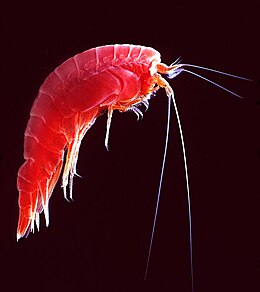
Plankton diversity
- Some of the diversity found in plankton
-
Pelagibacter ubique, the most common bacteria in the ocean, plays a major role in global carbon cycles
-
The tinycyanobacterium Prochlorococcusis a major contributor to atmospheric oxygen
-
Copepod from Antarctica, a translucent ovoid animal with two long antennae
-
Herring larva imaged with the remains of the yolk and the long gut visible in the transparent animal
-
Icefish larvae from Antarctica have no haemoglobin
-
Thectenophore has a transient anus which forms only when it needs to defecate[68]
-
Eel larva drifting with the gulf stream
-
Antarctic krill, probably the largest biomass of a single species on the planet
-
Microzooplankton are major grazers of the plankton: two dinoflagellates and a tintinnid ciliate.
-
Sargassum seaweed drifts with currents using air bladders to stay afloat
-
Planktonic sea foam bubbles with image of photographer
-
Macroplankton: a Janthina janthina snail (with bubble float) cast up onto a beach in Maui
Planktonic relationships
Fish & plankton
Zooplankton are the initial prey item for almost all
It's been shown that plankton can be patchy in marine environments where there aren't significant fish populations and additionally, where fish are abundant, zooplankton dynamics are influenced by the fish predation rate in their environment. Depending on the predation rate, they could express regular or chaotic behavior.[69]
A negative effect that fish larvae can have on planktonic algal blooms is that the larvae will prolong the blooming event by diminishing available zooplankton numbers; this in turn permits excessive phytoplankton growth allowing the bloom to flourish .[53]
The importance of both phytoplankton and zooplankton is also well-recognized in extensive and semi-intensive pond fish farming. Plankton population-based pond management strategies for fish rearing have been practiced by traditional fish farmers for decades, illustrating the importance of plankton even in man-made environments.
Whales & plankton
Of all animal fecal matter, it is whale feces that is the 'trophy' in terms of increasing nutrient availability. Phytoplankton are the powerhouse of open ocean primary production and they can acquire many nutrients from whale feces.[70] In the marine food web, phytoplankton are at the base of the food web and are consumed by zooplankton & krill, which are preyed upon by larger and larger marine organisms, including whales, so it can be said that whale poop fuels the entire food web.
Humans & plankton
Plankton have many direct and indirect effects on humans.
Around 70% of the oxygen in the atmosphere is produced in the oceans from phytoplankton performing photosynthesis, meaning that the majority of the oxygen available for us and other organisms that respire aerobically is produced by plankton.[71]
Plankton also make up the base of the marine food web, providing food for all the trophic levels above. Recent studies have analyzed the marine food web to see if the system runs on a
In some cases, plankton act as an intermediate host for deadly parasites in humans. One such case is that of cholera, an infection caused by several strains of Vibrio cholerae. These species have been shown to have a symbiotic relationship with chitinous zooplankton species like copepods. These bacteria benefit not only from the food provided by the chiton from the zooplankton, but also from the protection from acidic environments. Once the copepods have been ingested by a human host, the chitinous exterior protects the bacteria from the stomach acids in the stomach and proceed to the intestines. Once there, the bacteria bind with the surface of the small intestine and the host will start developing symptoms, including extreme diarrhea, within five days.[73]
See also
References
- ISBN 0-7506-3384-0.
- S2CID 86371218.
- ^ "plankter". American Heritage Dictionary. Houghton Mifflin Harcourt Publishing Company. Archived from the original on 9 November 2018. Retrieved 9 November 2018.
- .
- ^ Dolan, John (November 2012). "Microzooplankton: the microscopic (micro) animals (zoo) of the plankton" (PDF). Institut océanographique. Archived from the original (PDF) on 4 March 2016. Retrieved 16 January 2014.
- ^ Hansen, Victor (1887). "Uber die Bestimmung des Plankton's oder des im Meere treibenden Materials an Pflanzen und Thieren" [On the determination of the plankton or the material floating in the sea on plants and animals]. Fünfter Bericht der Kommission zur Wissenschaftlichen Untersuchung der Deutschen Meere (in German). 12 (12–16). Berlin, Germany: Paul Parey: 1-108 – via Biodiversity Heritage Library.
- ISBN 978-1-133-36446-7.
- ISBN 978-8-132-20864-8. Retrieved 2 April 2018.
- ^ "Plankter – marine biology". Encyclopædia Britannica.
- S2CID 131283465.
- ISBN 978-3-642-23342-5.
- PMID 10704475.
- ^ "Plankton". Resource Library. National Geographic. Retrieved 13 September 2019.
- .
- PMID 22451938.
- PMID 26831076.
- ^ "Mixing It Up in the Web of Life". The Scientist Magazine.
- ^ "Uncovered: the mysterious killer triffids that dominate life in our oceans". 3 November 2016.
- ^ "Catastrophic Darkness". Astrobiology Magazine. Archived from the original on 2015-09-26. Retrieved 2019-11-27.
- .
- ISBN 978-0-89464-653-9.
- ISBN 978-0-674-03116-6.
- PMID 22028628.
- ^ A. C. Hardy and P. S. Milne (1938) Studies in the Distribution of Insects by Aerial Currents. Journal of Animal Ecology, 7(2):199-229
- OCLC 34933503.
- ^ Blanchard, D.C., 1983. The production, distribution and bacterial enrichment of the sea-salt aerosol. In: Liss, P.S., Slinn, W.G.N. ŽEds.., Air–Sea Exchange of Gases and Particles. D. Reidel Publishing Co., Dordrecht, Netherlands, pp. 407-444.
- ^ Wallace Jr., G.T., Duce, R.A., 1978. Transport of particulate organic matter by bubbles in marine waters. Limnol. Oceanogr. 23 Ž6., 1155–1167.
- ^ WHO, 1998. Draft guidelines for safe recreational water environments: coastal and fresh waters, draft for consultation. World Health Organization, Geneva, EOSrDRAFTr98 14, pp. 207–299.
- ^ Klassen, R. D., & Roberge, P. R. (1999). Aerosol transport modeling as an aid to understanding atmospheric corrosivity patterns. Materials & Design, 20, 159–168.
- ^ Moorthy, K. K., Satheesh, S. K., & Krishna Murthy, B.V. (1998). Characteristics ofspectral optical depths and size distributions of aerosols over tropical oceanic regions. Journal of Atmospheric and Solar–Terrestrial Physics, 60, 981–992.
- ^ Chow, J. C., Watson, J. G., Green, M. C., Lowenthal, D. H., Bates, B., Oslund, W., & Torre, G. (2000). Cross-border transport and spatial variability of suspended particles in Mexicali and California's Imperial Valley. Atmospheric Environment, 34, 1833–1843.
- ^ Aller, J., Kuznetsova, M., Jahns, C., Kemp, P. (2005) The sea surface microlayer as a source of viral and bacterial enrichment in marine aerosols. Journal of aerosol science. Vol. 36, pp. 801-812.
- ^ a b Marks, R., Kruczalak, K., Jankowska, K., & Michalska, M. (2001). Bacteria and fungi in air over the GulfofGdansk and Baltic sea. Journal of Aerosol Science, 32, 237–250.
- ^ .
- S2CID 52336522.
- ^ Lalli, C.M. & Parsons, T.R. (2001) Biological Oceanography. Butterworth-Heinemann.
- ^ Johnsen, S. (2000) Transparent Animals. Scientific American 282: 62-71.
- ^ Nouvian, C. (2007) The Deep. University of Chicago Press.
- ^ What are Ichthyoplankton? Southwest Fisheries Science Center, NOAA. Modified 3 September 2007. Retrieved 22 July 2011.
- ISBN 9780520932470.
- ^ Harvey, Edmund Newton (1952). Bioluminescence. Academic Press.
- ^ Anderson, Genny. "Marine Plankton". Marine Science. Retrieved 2012-04-04.
- ^ Talks, Ted. "Zooplankton". Marine Life/Marine Invertebrates. Archived from the original on 2017-12-07. Retrieved 2012-04-04.
- ^ "Plankton". Britannica. Retrieved 2020-06-13.
- S2CID 199638114.
- ISBN 9783642800467.
- ^ ISBN 978-0123736215.
- ISBN 978-0520264212.
- ISBN 978-0849319600. Archived from the originalon 2013-01-20.
- S2CID 4325562.
- S2CID 4368261.
- S2CID 12129871.[permanent dead link]
- ^ ISSN 0304-3800.
- PMID 20513721.
- S2CID 8721854.
- hdl:10261/95626.
- hdl:10261/95626.
- ^ Petrou, Katherina; Nielsen, Daniel (2019-08-27). "Acid oceans are shrinking plankton, fueling faster climate change". phys.org. Retrieved 2019-09-07.
- S2CID 130687109.
- .
- ^ a b Roach, John (June 7, 2004). "Source of Half Earth's Oxygen Gets Little Credit". National Geographic News. Archived from the original on June 8, 2004. Retrieved 2016-04-04.
- .
- PMID 27814033.
- .
- .
- .
- .
- ^ Michael Le Page (March 2019). "Animal with an anus that comes and goes could reveal how ours evolved". New Scientist.
- PMID 11497628.
- ^ "whale poop and phytoplankton, fighting climate change". IFAW. Retrieved 2022-03-29.
- S2CID 8637912.
- PMID 17032358.
- PMID 12364378.
Further reading
- Kirby, Richard R. (2010). Ocean Drifters: A Secret World Beneath the Waves. Studio Cactus Ltd, UK. ISBN 978-1-904239-10-9.
- Dusenbery, David B. (2009). Living at Micro Scale: The Unexpected Physics of Being Small. Harvard University Press, Cambridge, Massachusetts ISBN 978-0-674-03116-6.
- Kiørboe, Thomas (2008). A Mechanistic Approach to Plankton Ecology. Princeton University Press, Princeton, N.J. ISBN 978-0-691-13422-2.
- Dolan, J.R., Agatha, S., Coats, D.W., Montagnes, D.J.S., Stocker, D.K., eds. (2013).Biology and Ecology of Tintinnid Ciliates: Models for Marine Plankton. Wiley-Blackwell, Oxford, UK ISBN 978-0-470-67151-1.
External links
- Ocean Drifters – Short film narrated by David Attenborough about the varied roles of plankton
- Plankton Chronicles Archived 2020-07-28 at the Wayback Machine – Short documentary films and photos
- COPEPOD: The Global Plankton Database – Global coverage database of zooplankton biomass and abundance data
- Plankton*Net – Taxonomic database of images of plankton species
- Guide to the marine zooplankton of south-eastern Australia – Tasmanian Aquaculture and Fisheries Institute
- Sir Alister Hardy Foundation for Ocean Science – Continuous Plankton Recorder Survey
- Australian Continuous Plankton Recorder Project – Integrated Marine Observing System
- Sea Drifters – BBC Audio slideshow
- [1] – Images of planktonic microorganisms
- Plankton, planktic, planktonic – Essays on nomenclature
- Journal of Plankton Research[dead link] – Scientific periodical devoted to plankton


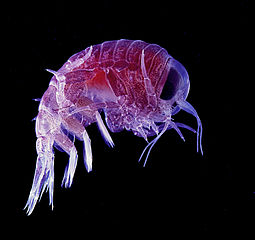
![Plankton sizes by taxonomic groups [23]](http://upload.wikimedia.org/wikipedia/commons/a/a3/Plankton_size.png)



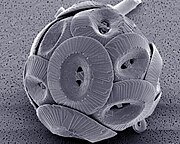








![The sea walnut ctenophore has a transient anus which forms only when it needs to defecate[68]](http://upload.wikimedia.org/wikipedia/commons/thumb/f/f8/Mnemiopsis_leidyi_2.jpg/255px-Mnemiopsis_leidyi_2.jpg)








